Welcome to the page with all the answers.
This page is all about what to expect before, during, and after your dog's In-Kennel Train & Stay at K9 Heeling. Please review this page in full so you can be as informed as possible.

Drop off details
when to drop off?
You will have a pre-determined, agreed upon time. If you cannot remember your drop off time, please contact us!
Where do I send my goals?
You can find a link to take you to our official Train & Stay intake form in the same email you found this link :)
what do I bring?
Please bring the following:
-
A flat collar and leash
-
Please bring their food in a sealed, plastic bin.
-
Any medications needed
**You DO NOT need food bowls, toys or bedding**
When I arrive?
For your convenience, please wait in your car, a team member will come to check you in.
Before Training
We’re so excited that you’ve committed to a better future for your family and your dog!
In an effort to get the most out of this experience for everyone (and every dog) involved we’re sharing the following information so that you can get the ball rolling in the right direction straight away.
First, here a link to a short video from President of K9 Heeling, Mitch Fletcher, to explain and demonstrate our process of building Food Motivation in our dogs.
Click here for the video: https://youtu.be/Ky4L_rjIoQ4
Second, to further explain the Food Motivation talked about in the video, read below for some clear direction on how to build that Food Motivation in your dog before their Train & Stay.
Intro to how we feed
At K9 Heeling, we focus on the use of a Primary Reinforcer (your dog’s food) to build motivation and incentivize the learning process. You will need to make sure that your dog is sufficiently motivated and willing to take food from your hand properly so that we can utilize food to incentivize the learning process and make your training sessions fun & exciting. Once they are motivated enough to take their regular food as rewards in a number of different settings, we can then start to make strategic decisions (such as increasing the value of rewards) based on factors such as distracting environments, competing motivators, etc. Some dogs are naturally more motivated for food than others, but no matter your dog’s genetic makeup, motivation for food rewards can be increased in a number of ways. So how do we achieve appropriate levels of motivation? Below we have provided you with some instructions for how to make sure that your dog is sufficiently motivated in order to maximize their learning ability.
Do's & Dont's of Feeding
Do not overfeed or free feed your dogs: Just as in humans, the number of calories ingested vs. the number of calories being used for fuel has a direct effect on weight, physical health, and mental health. Free feeding can also lead to unhealthy behavioral issues (such as resource guarding), and creates an unhealthy relationship with food. Knowing exactly how much food your dog is consuming daily is important information. Necessary adjustments can be made precisely if we are measuring their exact intake.
Use their food as a reward! Putting food in a bowl and leaving it out for your dog to pick at for long periods of time is a wasted opportunity. Rather than wasting opportunities to interact with and educate your dog, we will use the exchange and consumption of their food as a way to interact with them in a way that's meaningful, purposeful and educational. This will help to create motivation to interact with and learn from you.
Changing up the feeding rituals: This step will be especially helpful in transition away from free feeding and to build motivation in extremely finicky dogs. Start by giving your dog a time limit (1-2 minutes) to finish their food. If they don't seem interested or don't finish the food in time, pick up the food bowl, store the food properly and try again later. If they show little or no interest again, pick up the food bowl and try again the next day. Eventually you'll see a change in behavior and they will start to prioritize these opportunities for food. Once your dog is a consistently motivated enough to eat their food from the bowl right away, change the location of your feedings and set your time clock again. If you normally feed your do in the kitchen, start feeding them in a different room of the house or your backyard. Once they are consistently motivated enough to eat their food right away in the new location, change the location of your feedings again to a slightly more challenging environment. Take them just outside of your home or to a new location to feed them. Once you've consistently achieved high levels of interest and motivation for these feeding sessions in new locations, you are ready to move on to hand feedings.
All about hand feeding
Now that your dog is consistently prioritizing feeding opportunities from their bowl in new environments and around some competing motivators, you are ready to start the hand feeding process. Just as with the bowl, you will start hand feeding in comfortable, familiar areas of your home first, only moving to new locations after you are seeing consistently high levels of interest and motivation for the consumption of their food. Your dog should be ENTHUSIASTICALLY PUSHING INTO YOUR HAND for the food. Reference the “3 Prerequisites for training” video for visual examples of what a ‘non-motivated dog’ vs an ‘appropriately motivated dog’ looks like, and compare it to your pet’s own motivation level. If your pet is not showing a high level of interest in your interactions with their food, put the food away and try again later.
Once you have consistently achieved appropriate levels of motivation in a familiar setting with the least amount of distraction possible (typically this will be in your home) you will stop doing sessions in that setting and progress to a slightly more challenging environment (such as your back yard or just outside of your home). Once you have consistently achieved appropriate levels of motivation in this more challenging setting, you will again stop doing sessions in that setting and progress to a slightly more challenging environment (such as your front yard, down the street from your house or a local park). These changes of environment are crucial for teaching your dog to generalize that training sessions can happen anywhere and at anytime.
Keep in mind that it is not uncommon for dogs to drop in motivation initially when changing training environments. If you experience a drop in motivation when you make these changes, or your dog simply won’t focus after 1 or 2 minutes of trying, stop your session and try again later
in the day. The goal is to get your dog to choose training opportunities and interactions with you, over the competing motivators in the environment.
Be sure to always measure out your dog’s daily intake first thing in the morning. Knowing the precise amount of food your dog is ingesting each day is important. We recommend dosing out your pet’s food for the day in a designated container. If more than one person in your household will be participating in their training, the daily food container should be centrally located for everyone to access. We also recommend using a wearable feeding pouch or training vest so you can always have rewards handy, even for brief interactions. At this stage keep training sessions short (1 - 3 minutes). And do multiple sessions per day (2 - 5). Below we lay out a general progression which may help for planning the environmental changes for your sessions:
• Highly motivated for training sessions in your home
• Highly motivated for training in other familiar areas (other rooms, yard, etc)
• Highly motivated for training sessions just outside of your home
• Highly motivated for training sessions in new places (park, parking lot, busy part
of your neighborhood, etc)
During Training
While your dog is at the CalmPound, they will be worked with EVERY day MULTIPLE times per day.
Week 1:
In this first week, there will be lots of introductions to new things; including training tools, people, commands and expectations. Most importantly, your trainer and your dog will be building a relationship together where your dog is learning how to EARN all the things they want: affections, toys, and food. The dog will be working through Phase 1 which includes basic obedience; where they are learning to stay in their command until released with "okay." In addition, they are learning leash work where the dog is learning to move behind in a heel position along with responding to leash pressure.
Week 2:
Now that your dog has been introduced to all of the new things, now we can take it a step further by proofing all of the things they learned in Week 1 by adding challenges and distractions. By the end of this week, your dog should be fully on leash trained as well having high duration during their basic obedience commands. **If off-leash training, your dog will begin to wear their E-collar to get used to the feeling of it, as well as beginning the introduction of the stimulation.
Week 3:
In this final week, everything your dog has learned so far will be tested far and wide. To assist with this test, your dog will take a field trip to a location outside of the CalmPound in Eden, and experience these commands with unfamiliar distractions. Lastly, your trainer is going to make sure that all of the goals you listed in your intake form are being covered and your dog is ready to go home.
**We strive to share footage of your dog and post as often as we can. In the case that you may not see your dog on social media, don't worry, we're still hard at work with your dog every single day.**
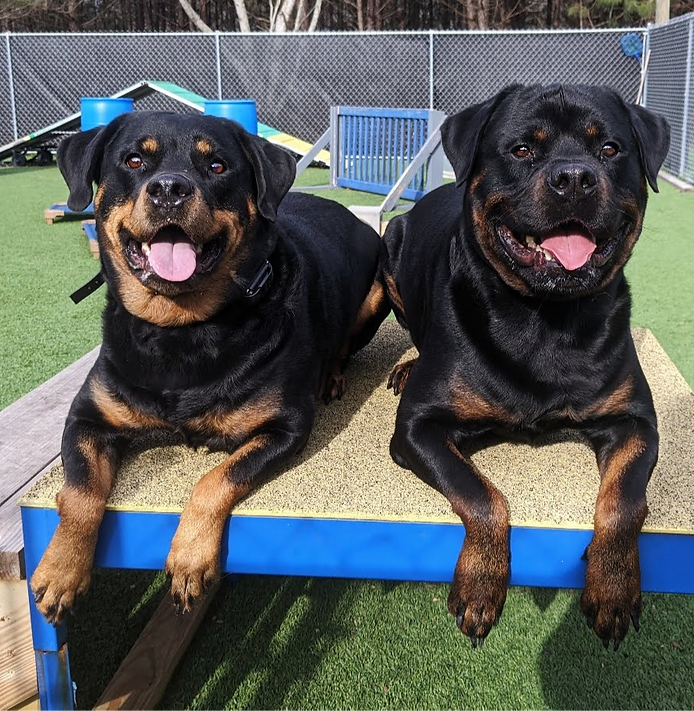
Daily schedule
Wondering what your dog's day is going to look like while staying with us at the CalmPound? This is a round-a-bout schedule of what that looks like:
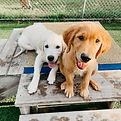.jpg)
7:30am-9:30am
First thing in the morning, your dog gets some potty time, breakfast and if approved in our group socials - social time.
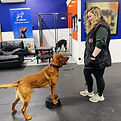.jpg)
1:30pm-3:30pm
After structured down time, your dog will partake in any remaining training/play sessions

9:30am-11:30am
The first training session or two happens right after all of their "business" is done.
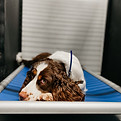
3:30pm-5:30pm
After a long day of training, we set up a second window for your dog to get some structured down time.
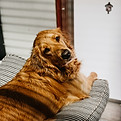
11:30Am-1:30pm
When not in training; your dog will have some structured down time in their crate or on a dog bed to rest and recover in preparation for more learning.
.jpg)
5:30pm-9:30pm
The rest of the night is devoted for potty time, dinner and if approved for our group socials - social time in two different social groups. Then, it's bed time :)
**If your dog is getting picked up every night instead of staying the night, this schedule will be adjusted and all of their training will be done before your pick up time.
knowledge transfer lessons
Your lessons will be taught by the trainer who has worked with your dog the entire week, which is ideal since they know your dog best, other than you of course.
You will be taught and practice everything your dog has learned during their week at the CalmPound. You will be asked to handle the dog and coached on how to continue the training at home, and pass on the same expectations held during their training with you at home.
This is the time to ask all of the questions, if you have any. Your trainer is here to help your family enjoy life together!
Want to bring home a fresh and clean dog?
We are firm believers in the principal of "Learning by Doing." When it comes to dog training it's possible your pup will be a "dirty dog" from the outdoor adventures.
Luckily for everyone; we have a fantastic, Certified Groomer on our team working from our on-site Dog Spa. Please let us know by Wednesday if you would like to add grooming services before a Friday Pick Up. Services and Pricing located here:


Let us know if you'd like to add any grooming services during your dog's train and stay!
AFTER TRAINING
We want to do everything we can to ensure the long term success of you and your furry friend. The best way we can do that is by helping you to understand as much of the PROCESS of dog training as possible.
A dog is not trained in 1, 2, or even 10 weeks. It takes time, and more importantly, it takes consistency. Keeping up with the principles of what you and your dog have learned is so important because they will be forgotten without practice. That being said, amazing things were accomplished while your dog was here! They have learned so much and had so much fun, but this was just the beginning of their training. We worked hard and your dog worked hard to lay a strong foundation. We added wanted behaviors and eliminated unwanted behaviors. We redirected undesired energy into something more meaningful for her and you. But most importantly, your dog learned HOW to LEARN and is now eager to participate in training.
The following steps will help you continue your dog’s progress:
-
Mental and physical stimulation on a daily basis.
-
Structure, rules, and boundaries followed consistently.
-
Positive interaction with you through play and formal obedience.
-
There must be rewards for doing right and consequences for doing wrong.
-
Reward good behavior whether you ask for it or not.
-
Correct unwanted behavior quickly… If you do not correct it then you are rewarding it.
Keep training simple but remember to keep it FUN! Your dog loves you more than anyone and when you become the person who keeps her mind sharp, the bond is that much stronger! We thank you so much for allowing us to work with your dog to become the best dog she could be for you.
We are here for you whatever you should need to make your dog's transition home smooth so feel free to call or email with any questions!







